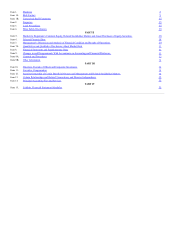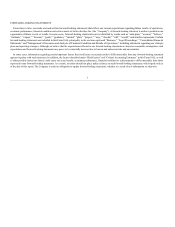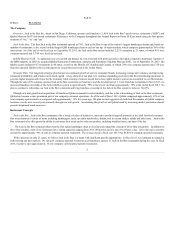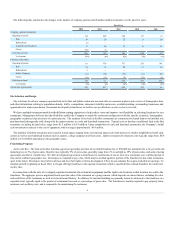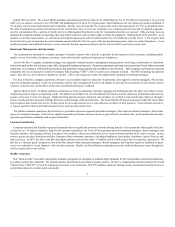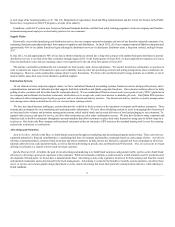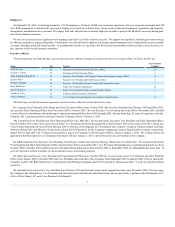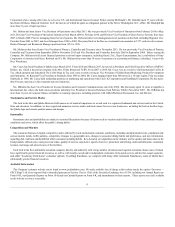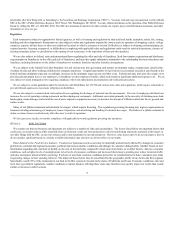Jack In The Box 2013 Annual Report Download - page 12
Download and view the complete annual report
Please find page 12 of the 2013 Jack In The Box annual report below. You can navigate through the pages in the report by either clicking on the pages listed below, or by using the keyword search tool below to find specific information within the annual report.
The performance of our business may also be adversely affected by factors such as:
•seasonal sales fluctuations;
•severe weather and other natural disasters;
•unfavorable trends or developments concerning operating costs such as inflation, increased costs of food, fuel, utilities, technology, labor (including
due to legislated minimum wage increases or employee relations issues), insurance and employee benefits (including healthcare, workers’
compensation and other insurance costs and premiums);
•the impact of initiatives by competitors and increased competition generally;
•lack of customer acceptance of new menu items or potential price increases necessary to cover higher input costs;
•customers trading down to lower priced items and/or shifting to competitors with lower priced products;
•the availability of qualified, experienced management and hourly employees; and
•failure to anticipate or respond quickly to relevant market trends or to implement successful advertising and marketing programs.
In addition, if economic conditions deteriorate or are uncertain for a prolonged period of time, or if our operating results decline unexpectedly, we may be
required to record impairment charges, which will negatively impact our results of operations for the periods in which they are recorded. Due to the foregoing or
other factors, results for any one quarter are not necessarily indicative of results to be expected for any other quarter or for a full fiscal year. These fluctuations
may cause our operating results to be below expectations of public market analysts and investors, and may adversely impact our stock price.
Risks Related to Food and Commodity Costs. We and our franchisees are subject to volatility in food and commodity costs and availability.
Accordingly, our profitability depends in part on our ability to anticipate and react to changes in food costs and availability, including changes in fuel costs
and other supply and distribution costs. For example, prices for feed ingredients used to produce beef, chicken and pork could be adversely affected by
changes in worldwide supply and demand or by regulatory mandates, leading to higher prices. Further, increases in fuel prices could result in increased
distribution costs. In recent years, food and commodity costs increased significantly, out-pacing general inflation and industry expectations. Looking forward,
we anticipate volatile or uncertain price conditions to continue.
We seek to manage food and commodity costs, including through extended fixed price contracts, strong category and commodity management, and
purchasing fundamentals. However, certain commodities such as beef and pork, which represent approximately 20% and 8%, respectively, of our overall
commodity spend, do not lend themselves to fixed price contracts.
We cannot assure you that we will successfully enter into fixed price contracts on a timely basis or on commercially favorable pricing terms. In addition,
although we have fixed price contracts for produce, we are subject to force majeure clauses resulting from weather or acts of God that may result in temporary
spikes in costs.
Further, we cannot assure you that we or our franchisees will be able to successfully anticipate and react effectively to changing food and commodity costs
by adjusting our purchasing practices or menu offerings. We also may not be able to pass along to our customers price increases as a result of adverse
economic conditions, competitive pricing or other factors. Therefore, variability of food and other commodity costs could adversely affect our profitability and
results of operations.
A significant number of our Jack in the Box and Qdoba restaurants are company-operated, so we continue to have exposure to operating cost issues.
Exposure to these fluctuating costs, including increases in commodity costs, could negatively impact our margins as well as franchise margins and franchisee
financial health.
Risk Related to Our Brands and Reputation. Multi-unit food service businesses such as ours can also be materially and adversely affected by
widespread negative publicity of any type, particularly regarding food quality, nutritional content, safety or public health issues (such as epidemics or the
prospect of a pandemic), obesity or other health concerns, and employee relations issues, among other things. Adverse publicity in these areas could damage
the trust customers place in our brands. The increasingly widespread use of mobile communications and social media applications has amplified the speed
and scope of adverse publicity and could hamper our ability to promptly correct misrepresentations or otherwise respond effectively to negative publicity.
To minimize the risk of food-borne illness, we have put in place HACCP systems for managing food safety in our restaurants and with our vendors.
Nevertheless, food safety risks cannot be completely eliminated. Any outbreak of illness attributed to company or franchised restaurants, or within the food
service industry, or any widespread negative publicity regarding our brands or the restaurant industry in general could cause a decline in our and our
franchisees’ restaurant sales, and could have a material adverse effect on our financial condition and results of operations.
In addition, the success of our business strategy depends on the value and relevance of our brands and reputation. If customers perceive that we and our
franchisees fail to deliver a consistently positive and relevant experience, our brands could suffer. This could have an adverse effect on our business.
Additionally, while we devote considerable efforts and resources to protecting our
10


